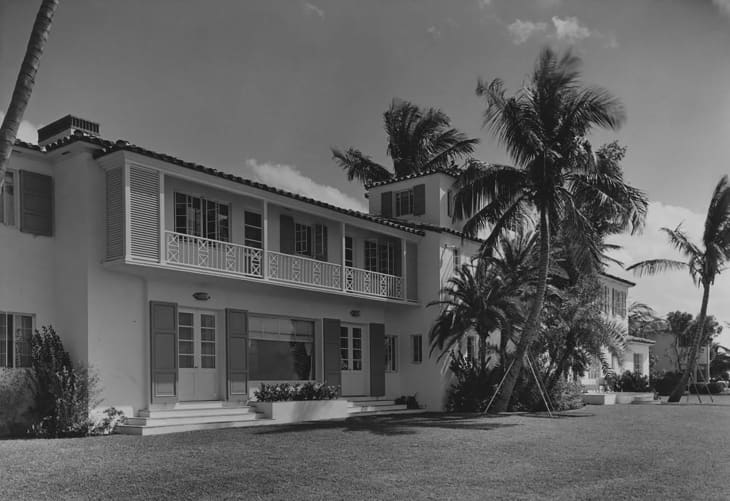The 7 Types of Homes Everyone Was Buying in the 1920s

If you’re like me, trying to picture life in the 1920s conjures images of “Great Gatsby”-esque soirées in Art Deco mansions. But homes for the average American weren’t all glitz and glamour. Some were wood-shingled, others had tiled roofs—and a startlingly large number of them were brand-new.
The 1920s saw a historic housing boom, with modest residential homes springing up in styles of all kinds, thanks to new construction technologies. Architects like Frank Lloyd Wright and Louis Sullivan had a hand in influencing what was en vogue—clean lines and geometric shapes—but for the most part, it was an age of variety.
Servicemen returning from World War I sought European-style homes that recalled the Mediterranean cottages of Italy and the Tudor manses of England. Fast-growing suburbs saw a surge of Craftsman bungalows, and Bauhaus artists set the stage for sleek, modern abodes. Ahead, find seven popular residential architectural styles of the 1920s.
Craftsman
The low-pitched roofs and overhanging eaves of Craftsman bungalows came into existence after the Arts & Crafts movement—or in other words, well before the 1920s—but remained in favor throughout the decade. According to Frederik Heller, director of library services for the National Association of Realtors, bungalows were the most ubiquitous house style of the time because they were small, quick to construct, relatively affordable, and could be built close to one another without overcrowding a street. Bungalows were also one of the most common options in Sears Roebuck & Co.’s build-your-own kit houses catalog, which allowed buyers to order homes by mail.
Tudor Revival
Recalling the Medieval-era cottages of England, Tudor Revival homes were built in all shapes and sizes, from sprawling Tudor manors to smaller suburban versions. Their decorative half-timbering, steeply pitched roofs, casement windows, and other ornate flourishes are easily recognizable. Old House Journal speculates their popularity was a declaration of English-heritage allegiance during a time of increased immigration, or as a tip of the hat to one of America’s allies in WWI.
Cape Cod
Named for the hook-shaped arm of Massachusetts where they originated, Cape Cod-style homes are a humble Yankee invention. Puritan settlers modeled them after their timber cottages in England, keeping the design details to a minimum. Typically, they’re clad in shingles, have a central door with two windows on each side of it, and are topped with a chimney. An architect named Royal Barry Wills is credited with a resurgence of Cape Cod-style abodes in the mid-20th century. The Massachusetts native “wanted only to design the indigenous New England house supremely well, and succeeded beyond any other architect,” reads “More Houses for Good Living,” a book originally published in 1968 by his firm.
Colonial Revival
Colonial Revival and Tudor Revival homes sprang up around the same time, and were a top choice for many builders. According to “A Field Guide to American Houses” by Virginia Savage McAleester, about 40 percent of homes were built in Colonial Revival style between 1910 and 1930. Rather than stick to traditional Saltbox Colonial roots, many Colonial Revival homes mix features from Federal- and Greek Revival-style homes. Their facades show symmetrically balanced windows with a center door, and can have intricately detailed entrances, cornices, and windows.
Dutch Colonial
Identifiable by their gambrel roofs and dormer windows, Dutch Colonial homes don’t originate from the Netherlands or the U.S. colonies—they’re actually named after the Dutch Colonists who settled southern New York and parts of New Jersey. A shining example is the Vander Ende-Onderdonk House on the border of Brooklyn and Queens—it’s the oldest Dutch Colonial home still standing in New York City. In the early 1900s, scores of Dutch Colonials were built in suburbs across the country.
Modernist
The Roaring ‘20s were nothing if not rebelliously avant-garde, and the Modernist homes of the 1920s fit that bill. Designed with smooth wall surfaces and flat roofs, they were influenced by the no-frills design ideals of the Bauhaus, a modernist art school in Germany. Many early Modernist homes featured Art Deco elements, like chevrons, zig zags, and other geometric motifs. Later examples had rounded corners, walls of glass blocks, and circular windows.
Mediterranean
Much like the Mediterranean Sea, Mediterranean homes of the 1920s touch many countries. Elements of Italian, Spanish, and French architecture are fused together in the style, which was popular in the American West. These houses are mainly characterized by a stucco exterior and a tiled roof, while more ornate versions feature columns, pilasters, patterned tiles, stonework, and iron window grilles. Mediterranean homes represented wealth and grandeur, and remained popular until the Great Depression.